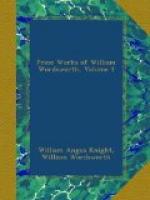My purpose in writing this Series was, as much as possible, to confine my view to the ’introduction, progress, and operation of the CHURCH in ENGLAND, both previous and subsequent to the Reformation. The Sonnets were written long before Ecclesiastical History and points of doctrine had excited the interest with which they have been recently enquired into and discussed. The former particular is mentioned as an excuse for my having fallen into error in respect to an incident which had been selected as setting forth the height to which the power of the Popedom over temporal sovereignty had attained, and the arrogance with which it was displayed. I allude to the last sonnet but one in the first series, where Pope Alexander the Third, at Venice, is described as setting his foot on the neck of the Emperor Barbarossa. Though this is related as a fact in history, I am told it is a mere legend of no authority. Substitute for it an undeniable truth, not less fitted for my purpose, namely, the penance inflicted by Gregory the Seventh upon the Emperor Henry the Fourth, at [Canosa].[4]
[4] (’According to Baronius the humiliation of the Emperor was a voluntary act of prostration on his part. Ann. Eccl. ad Ann. 1177.’ Memoirs, ii. 111.)
Before I conclude my notice of these Sonnets, let me observe that the opinion I pronounced in favour of Laud (long before the Oxford Tract movement), and which had brought censure upon me from several quarters, is not in the least changed. Omitting here to examine into his conduct in respect to the persecuting spirit with which he has been charged, I am persuaded that most of his aims to restore ritual practices which had been abandoned, were good and wise, whatever errors he might commit in the manner he sometimes attempted to enforce them. I further believe, that had not he, and others who shared his opinions and felt as he did, stood up in opposition to the Reformers of that period, it is questionable whether the Church would ever have recovered its lost ground, and become the blessing it now is, and will, I trust, become in a still greater degree, both to those of its communion, and those who unfortunately are separated from it:
‘_ 1 saw the Figure of a lovely Maid_.’ [Sonnet I. Part III.]
When I came to this part of the Series I had the dream described in this sonnet. The figure was that of my daughter, and the whole past exactly as here represented. The sonnet was composed on the middle road leading from Grasmere to Ambleside: it was begun as I left the last house in the vale, and finished, word for word, as it now stands, before I came in view of Rydal. I wish I could say the same of the five or six hundred I have written: most of them were frequently retouched in the course of composition, and not a few laboriously.
I have only further to observe that the intended church which prompted these Sonnets was erected on Coleorton Moor, towards the centre of a very populous parish, between three and four miles from Ashby-de-la-Zouch, on the road to Loughborough, and has proved, I believe, a great benefit to the neighbourhood.




